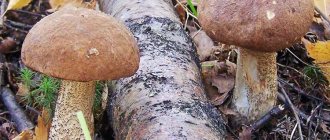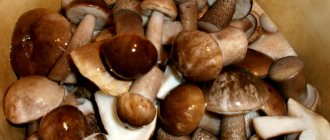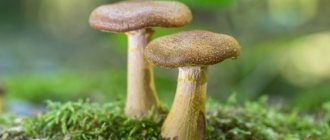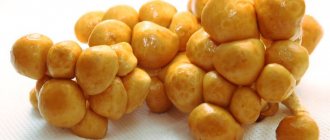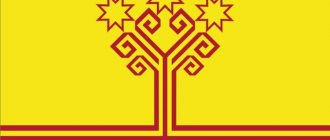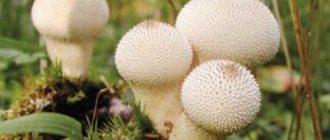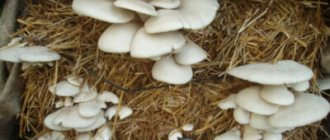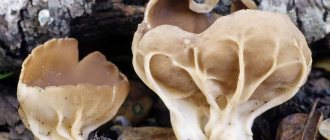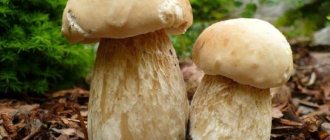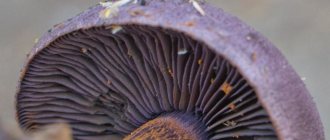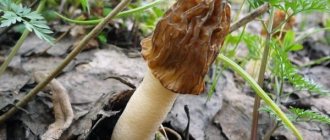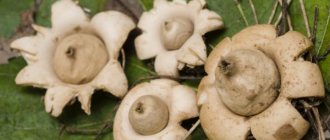The autumn forest fascinates everyone not only with its colors and nature, but also with the opportunity to collect delicious mushrooms for harvesting or freezing.
In the fall, many mushroom pickers go for honey mushrooms, but here you need to know in what period it is best to collect them and in which forests these mushrooms grow well. Under suitable conditions, you can collect a whole body of honey mushrooms.
Autumn honey fungus, also known as real honey fungus
If in the fall you happen to see a basket of freshly picked honey mushrooms at the market or at a mushroom picker you know, then most likely this is the autumn honey fungus (see photo at the beginning of the article). This mushroom is very widespread throughout the temperate zone of our continent (by the way - in North America too), and in certain years - when there is a wet and more or less warm autumn - it bears fruit so en masse that half a ton of it is collected from one hectare.
Autumn honey fungus is found in any forest - both coniferous and deciduous. It is extremely indiscriminate in its choice of host and can parasitize on a fair number of plants, including all the trees known to us, as well as a wide variety of shrubs and herbs. Under favorable conditions, it is capable of temporarily “retraining” from a parasite into a saprophyte and feeding on dead plant debris.
The autumn honey fungus is very recognizable, therefore it is recognized quite quickly even by novice mushroom pickers. Its fruit bodies usually have a pleasant-looking yellowish color - the color of honey (for which it is called “honey mushroom” in Latin), or not very intensely orange, or light brown. Some experts associate the shade with the wood on which the honey fungus grows.
Still young, but edible honey mushrooms grow in dense clusters, have small - 3-5 cm in diameter, convex caps with slightly turned up edges on thin but strong legs - up to 10 cm long, often merging at the base. Both the caps and legs are usually covered with dark scales, which disappear with age (in the center of the cap these scales form a kind of dark spot). An obligatory attribute (one of the signs by which autumn honey fungus can be distinguished from poisonous false honey mushrooms) is a ring on a stalk almost at the very base of the cap, left over from the bedspread. And the younger the mushroom, the more likely it is that it will be a membrane - full or partial, covering the plates on the inside of the cap.
Photo 2. Young fruiting bodies of honey fungus on the roots of an old tree. Author: Andreas Eichler
With age, the cap of the honey fungus unfolds, expands and flattens. Its flesh becomes coarse, making it virtually unfit for food. Perhaps such mushrooms can be used for decoction (and then thrown away), or they can be fried, stewed and finely rolled into caviar. But, as practice has shown, with age the honey fungus not only becomes stiff, but also somewhat loses its taste, which is why more or less picky mushroom pickers categorically neglect it.
Photo 3. A decent “plantation” of ripened fruiting bodies of the autumn honey fungus on old, almost rotten woody remains. Author: Harlock81.
Autumn honey fungus begins to bear fruit in August - towards the end of the month; it appears most en masse in our forests in September , despite all this - it continues to release fruiting bodies until October - until the very beginning of the real winter (in other years, when the autumn is warm - it can be collected until December ).
Seasoned mushroom pickers claim that honey mushrooms come in “three layers,” and you can also hear a story from them that mushrooms can appear in July, but such a statement is due to ignorance of scientific subtleties. For at the height of summer, slightly different types of honey mushrooms appear.
When will the autumn honey mushrooms begin?
The autumn forest can delight mushroom pickers with whole families of honey mushrooms, so if you manage to choose the place and time of their active growth, you will be able to collect a decent amount of harvest.
You should start collecting this type of edible mushrooms in September. Honey mushroom growth usually begins in August, but the most active period for fruiting is September.
Therefore, experienced mushroom pickers go to harvest closer to mid-September and until October you can safely look for places where this type of mushroom grows.
The fruitful honey fungus first appears towards the end of August; sometimes mushroom pickers go to the forest for the feast of the Blessed Virgin Mary just for young mushrooms. Therefore, the report can safely begin on August 28: for three weeks from this period there will be active growth of young autumn mushrooms. If the weather is too hot and without rain, the harvest season will shift slightly.
This type of mushroom loves moisture and warmth, but during drought it almost does not grow. Therefore, you should take into account the weather and climatic features of the region in order to know when it is better to go to the forest to pick mushrooms.
But you should focus on the beginning and middle of September, since in most regions this period is ideal for the growth of autumn honey fungus.
Northern honey fungus
He is also the northern autumn honey fungus. In many ways it is similar to the previous mushroom, except that it differs in color - it is more often light brown than yellow, at least in our area. It also sometimes looks a little stronger.
Photo 5. Mature fruiting bodies of the northern honey fungus. Author: Kärt Urman.
In terms of other characteristics - from the preferred forests to the timing of fruiting - this mushroom fully corresponds to the autumn honey fungus.
Dangerous Dark Honey fungus
In addition to edible honey mushrooms, useful for consumption, the forest areas of Russia, Ukraine and Belarus are known for the deposit of conventional mushrooms. For safe consumption, double heat treatment is recommended, including boiling, followed by draining the broth and rinsing with running water. Dark honey fungus is just from this list. When collecting during the season, do not neglect the rules, reducing processing time. The required amount of time will eliminate digestive problems or poisoning.
Autumn thick-legged honey fungus
It differs from the usual autumn honey fungus in having a thicker leg at the base, its color is almost identical, but at times it is somewhat lighter and paler, and sometimes with light scales instead of dark ones. In addition, this mushroom looks stronger and does not grow in large clusters, but throws out fruiting bodies in groups of no more than a dozen. Not seen on living trees; it feeds on rotting plant debris, so it can more often be found on windbreaks and forest floors.
Fruits from August to October - evenly, without “layers”. In particularly warm years, fruiting bodies may appear as early as July. It is edible and is not inferior in taste to ordinary autumn honey fungus.
How to collect honey mushrooms correctly
Once you find the Armillaria family, you can easily harvest a large harvest very quickly. In this case, you should follow some collection rules:
- take familiar mushrooms;
- It is best to harvest in the early morning, when the mushrooms are saturated with cool dew, are more elastic and tolerate transportation well;
- give preference to young specimens, they are, as a rule, tastier and not worm-eaten, and also do not have time to absorb many harmful substances;
- when collecting, you need to carefully trim the stem of the fruiting body or unscrew it, trying not to spoil the mycelium;
- the collected product must be laid with its caps down or on its side;
- in its raw form, the harvest is not stored for a long time; it must be processed immediately after arriving home.
Did you know? In the presence of sunlight, mushrooms produce vitamin D and are able to “tan”, changing pigmentation.
Mushroom picking brings real pleasure to connoisseurs of this process. Autumn honey mushrooms have a rich chemical composition. They can not only satisfy hunger, but also satisfy the needs of the most picky gourmets, and also have a healing effect on the body. Guided by the basic rules for collecting Armillaria, you can reap a good harvest and please yourself and your loved ones.
Autumn bulbous honey fungus
It is very similar to the previous mushroom (as well as to other autumn mushrooms), especially with a stalk, which has a characteristic tuberous swelling at the very base - but usually those mushrooms that grow on trees, those that appear on the ground, have a “standard” stalk ", thin. However, the cap of the bulbous honey fungus is usually noticeably darker than the stem, and the color of the entire fruiting body is often quite bright, varying from brown to outright yellow tones.
The bulbous honey fungus bears fruit from August to September (the peak of fruiting occurs in the second month), usually appears in deciduous forests in a friendly layer on dead wood, old stumps and rotted wood debris.
Photo 8. Young fruiting bodies of the bulbous honey fungus on mossy dead wood. Author: Tony Hisgett.
In terms of edibility, it is somewhat inferior to real honey fungus (this is especially true for frail fruiting bodies growing on the soil). Mushroom pickers who know a lot about honey mushrooms note that it is better to throw away the very bottom part of the stem - it is, as a rule, especially hard and has completely unsightly nutritional qualities.
Five benefits of eating honey mushrooms
Honey mushrooms are classified as plant pathogens because they commonly cause armillaria root rot in many plant species.
Healthy source of natural proteins and vitamins
300 grams of honey mushrooms contain as much as 4 g of proteins. Vitamin C, which is necessary for protein metabolism and is an important component of connective tissue, is also present in honey mushrooms (link).
Low calorie
Honey mushrooms' calorie content does not exceed 30 calories, which is 1% of the daily requirement. This is in the form of carbohydrates, which are an excellent source of energy (link).
Source of dietary fiber
Dietary fiber, in this case, refers to the rough part of mushrooms that your body cannot digest. They play a vital role in filling and maintaining a healthy digestive system. For every ounce of honey mushrooms, you'll get 1 gram of dietary fiber (link).
Contains essential minerals
Honey mushrooms contain the minerals calcium, iron and sodium. Your body always has a constant need for calcium, a significant amount of which is used to maintain healthy bones and teeth. Honey mushrooms contain at least 40 mg of calcium in every ounce.
Iron underlies the formation of hemoglobin, which is responsible for the transport of oxygen. Honey mushrooms contain at least 0.9 mg of iron.
Sodium helps regulate the body's electrolyte balance. It also has a positive effect on muscle function and normalization of nerve functions (link).
Rich in Antioxidants
Honey mushrooms are rich in antioxidants, which are elements that slow down the destruction of healthy body cells. This ensures that only damaged cells are replaced (link).
Honey fungus shrinking
He is also an oak honey fungus, a ringless honey fungus. Another species from the genus of true honey mushrooms, preferring broad-leaved species to other trees. It is most often collected from oak trees, which is why it received one of its alternative names. It is also not called ringless for nothing - the fruiting bodies of the honey mushroom do not have a drying cover, so its stem is always without a ring, which greatly increases the chances of confusing this mushroom with false honey mushrooms, so only experienced mushroom pickers collect it.
Photo 10. Close-up of the fruiting bodies of the shriveling honey fungus. Author: Katja Schulz.
However, the typical “honeycomb” hairiness of the fruiting body and the presence of scales on the cap are eloquent signs that make it clear that we are dealing with a representative of true honey mushrooms.
This mushroom bears fruit from July to October . In warm summers, fruiting bodies may appear earlier - as early as June.
In terms of taste, the shrinking honey mushroom corresponds to other real honey mushrooms.
Summer honey fungus
This mushroom, despite its considerable similarity, has nothing to do with real honey mushrooms. This is a representative of fungi with the unpronounceable name “Kyneromyces”. However, it is quite edible and is collected just as actively.
It grows on damaged living trees, but prefers rotten wood, and not just any wood, but deciduous wood (although sometimes this fungus is also observed on coniferous trees).
Photo 12. The lower surface of the cap of the summer honey fungus. Author: Björn S…
Summer honey fungus bears fruit virtually throughout the warm season - from April to November (and in countries with a mild climate - all year round).
The size of the fruiting bodies of the summer honey fungus is slightly different than that of the autumn one - the cap does not grow more than 6 cm in diameter, the leg is also three centimeters shorter. The color is somewhat lighter, more yellowish. The main difference is a wide tubercle on the cap, very noticeable - usually light, but sometimes dark. In addition, the caps of summer honey mushrooms are often smooth, and if they have scales, they are light.
This mushroom has a poisonous “double” (which will be discussed below in the chapter on the distinctive features of edible mushrooms from false and poisonous ones), so only experienced mushroom pickers collect it.
Correctly cutting mushrooms
Beginning mushroom pickers need to know that if they harvest incorrectly, they can damage the mycelium and then it will no longer bear fruit. Because of such mistakes, myceliums die out in forests.
In general, experienced mushroom pickers prefer to cut mushrooms and this is completely justified. This way the mycelium is not damaged.
It is better not to cut off very small ones, but to allow them to grow to the desired size.
And if the mushrooms are already old, then it is better to leave them in place, but not trample them, since they will make it possible to continue the genus of mushrooms.
Thus, it is recommended to carefully cut off the honey mushrooms so as not to damage the mycelium. There is no need to actively cut off everything in your path, including small mushrooms, as they can still grow. Tearing with your hands is also highly undesirable.
Winter honey fungus
This mushroom - despite the name, as well as some external resemblance to true honey mushrooms and the “habit” of growing on stumps and trees - is by no means a honey mushroom. To be honest, this is the most natural row.
Photo 14. Winter honey mushrooms - the lower surface of the caps. Author: Eric Steinert.
But it is called “winter” for a reason - it is one of the few mushrooms of our latitudes that can develop at very low temperatures, close to zero.
The fruiting season for winter honey fungus is from late autumn to early spring .
It’s clear that in 40-degree frosts you won’t get a harvest from it - at this moment it will be in a state of suspended animation. But as soon as the thaw sets in, the mushroom instantly comes to life and throws out fruiting bodies, which can be seen even in the city - peeking out from under the snow - on ancient, well-worn poplars, or stumps - left over from them.
In addition to poplars, this fungus “occupies” willows, less often other deciduous trees, mainly old or damaged ones, as well as everything that remains from their felling or windfall. It grows everywhere, from forests to parks and gardens, but it is especially abundant along the banks of small rivers and streams.
In warm winters, I often observe winter mushrooms in the yard of my house - on old poplars. Mushrooms look very unusual, dusted with snow.
Winter honey fungus is edible and has a very good taste, for which it is cultivated in Japan and Korea, and recently in some other countries. It is known throughout the world under the trade name “enokitake”; the youngest fruiting bodies, grown in the dark and devoid of pigment, similar to bunches of light “pins”, are sold.
Photo 16. Winter honey mushrooms grown on an artificial substrate - “enokitake”. Author: Wendell Smith.
However, in our country it is not collected by all mushroom pickers: winter honey fungus is very similar to false honey mushrooms - it does not have a ring on the stem, and its color is just as bright. In addition, there is information that this mushroom may contain a small amount of toxins that cause digestive upset (for which it is always recommended to boil it first).
The cap is from 2 to 10 cm in diameter, convex in young fruiting bodies, flat in old ones, usually has a yellowish or orange-brown color, richer in the center, paler at the edges. The leg is up to 7 cm long, up to 1 cm in diameter, hollow inside, velvety, brownish-yellowish, lighter in the upper part.
Experienced mushroom pickers recognize and distinguish it without difficulty. The main feature is the time of growth. In winter, by definition, no false honey mushrooms can bear fruit, especially on trees, and winter honey mushrooms sometimes “climb” very high.
FALSE DOUBLES
Galerina Marginata. This mushroom often grows on wood and in clusters with relatively small caps. The brown or tan hue changes with age, making it difficult to differentiate simply by comparing colors. The best way to distinguish this mushroom from honey fungus is to observe the spore print. Galerina marginalata has a red-brown spore print, while honey mushrooms have a whitish spore print.
Foliota Aurivel. Foliota aurivella belongs to the genus Foliota. These mushrooms have brownish spore prints and gills that are attached to the stem but do not flow down it. They also have smooth spores with pores, unlike honey mushrooms, which have small, iridescent hairs.
A bunch of sulfur. These brown and tan mushrooms have gills that are attached to the stem. Again, the only way to distinguish this poisonous species from honey fungus is by spore print, in which tufts of sulfur have a purple-brown spore print.
Honey fungus
Another fake honey fungus, which is directly related to non-rotting mushrooms. It is named honey mushroom only for its partial external resemblance to true honey mushrooms, but otherwise it is not at all similar to them.
Fresh fruiting bodies of the meadow honey fungus are usually small: the cap is on average 5 cm in diameter, the stem is 6 cm long, occasionally there are specimens with an 8-centimeter cap and a stem up to 10 cm. The color is ocher-brownish, depending on the weather: in the heat it is paler than at high humidity (in this case the cap also becomes sticky). The mushroom does not have a ring on the stem - which is why it is similar in appearance to some “toadstools”, so only experienced mushroom pickers collect it. However, in some places the meadow honey fungus is quite popular.
This mushroom avoids forests, preferring open spaces overgrown with grass, especially those where cows and other herbivores often graze, and the ground is well fertilized. The honey fungus is a typical saprophyte that feeds on organic debris.
It bears fruit almost throughout the warm season - from the end of May to the end of October .
What and how affects the growth of honey mushrooms
The growth of honey mushrooms is influenced by a large number of factors, so it is impossible to clearly determine when you will get the optimal harvest. Experienced mushroom pickers still have their own observations and ideas about how long after precipitation and under what weather conditions it is worth going on a “quiet hunt.”
Important! Mushrooms, like a sponge, absorb all the components of the environment. Therefore, under no circumstances should you collect them near roadways, enterprises and other places with high concentrations of harmful substances.
At what temperature do they grow?
Honey fungus grows at temperatures from +8 to +13°C . When the soil and air warm up to more than +15°C, the mushroom caps disappear. Accordingly, the peak of growth does not occur in any specific month, but is regulated solely by the ambient temperature. When the temperature drops closer to winter, honey mushrooms disappear only as the soil freezes. External cold does not frighten them as long as the mycelium is warm.
How quickly they grow after rain
Armillaria grows on average from a day to a week. The heavier the rain and the more favorable the temperature conditions, the more likely it is that you will find a mushroom harvest in the ravines on rotten stumps.
On average, the growth of the fruiting body per day is 1.5–2 cm. The fruiting bodies of honey mushrooms live up to fifteen days. They stop growing on the eleventh day.
"Royal honey fungus" (hairy scale)
This example of the mushroom kingdom also has nothing to do with honey mushrooms. Nevertheless, among the people the nickname “royal honey fungus” has stuck to it, so I will still mention it.
It was called “royal” primarily for its appearance - the mushroom looks very impressive and photogenic, has a beautiful bell-shaped cap and is completely covered with large scales, the pattern of which vaguely resembles a royal robe.
As for the taste, the opinions of mushroom pickers are divided. Some consider this mushroom to be tasteless, while others, on the contrary, praise it and value it higher than the usual autumn mushroom. The fleecy scale has a distinct “rare” taste and smell.
“Royal honey fungus” grows in any forest - on stumps and trunks of old trees on rotting wood. Fruits from mid-August to late autumn .
About the places where honey mushrooms grow
It would seem that it is easier to find honey mushrooms than steamed turnips: purely logically, they should be in any forest in which their potential host plants grow. But in reality, everything turns out to be more complicated: we are surrounded by giant forests, but no matter where honey mushrooms are found in them, but only in special places - which are “registered” with seasoned mushroom pickers and are strictly classified.
Why is that? The thing is that trees and shrubs have existed side by side with parasitic fungi for millions of years, and over this very considerable period they have “learned” to defend themselves quite successfully from them.
The first bastion of this defense is the bark, which is essentially an armor through which no spores can grow. If the tree bark is intact, then it is not afraid of parasitic mushrooms.
If suddenly the bark is damaged, then a second means of defense comes into play - chemical substances that suppress the development of fungi (garden fungicides are a kind of analogue of these substances). Any plant secretes especially a lot of these substances at a young age - when it develops intensively.
Therefore, in places where the trees are young and healthy, honey mushrooms are unlikely to bear fruit, it most likely makes no sense to look for these mushrooms there.
But where the trees are old or damaged, where there are stumps, fallen trunks or dead wood, honey mushrooms, as a rule, develop “with a bang” and throw out their fruiting bodies quite quickly. If you want to find them, go to some old forest, for example, with huge birch trees, whose trunks are 80 centimeters in diameter. And pay attention to the butt and roots of these very trunks - if they are quite overgrown with moss and lichen, it means that all the necessary conditions for mushrooms have been met. Here honey mushrooms grow not only on the bark of old trees (sometimes “climbing” very high), but also on their roots, so they can often be seen not on the trunk, but right on the ground.
The next places where you can successfully collect honey mushrooms are clearings, and it doesn’t matter at all whether they are fresh or old. Although it has been noted that in ancient clearings honey mushrooms grow more intensively, the fact that the first fruiting bodies appear on stumps a little more than six months after logging is known for certain.
In places where the felling of trees occurred for natural reasons - from the wind, for example, honey mushrooms also appear quite quickly. Therefore, any areas of the forest littered with windfall also need to be inspected during collection.
From my own experience, I can also add the following: honey mushrooms (at least ours - the Ural ones) do not particularly like places well warmed by the sun. They definitely prefer shade and some coolness, so you should look for them on the northern slopes of the mountains, in logs or ravines, as well as in spruce forests mixed with other trees.
In such places, I often observed breathtaking accumulations of mushrooms that covered everything with an orange carpet - stumps, the base of trees, fallen trunks, and the forest floor. From one average stump it was possible to easily cut a whole basket of honey mushrooms.
The main thing is to be in such a place on time - when the fruiting bodies are still small, tender, and have not developed into “burdocks”, at the same time becoming tough and inedible.
Growing summer mushrooms at home
While in Russia summer honey mushrooms come to the table almost exclusively from the forest, in some European countries this mushroom is grown on an industrial scale. In our country, entrepreneurs do not grow honey mushrooms due to the fact that this mushroom spoils too quickly and is not as convenient for commercial cultivation as champignons, tasteless against honey mushrooms, but stored for a long time.
Fortunately, the Internet has given us a lot of opportunities for exchanging ideas and goods, so today anyone can purchase honey fungus mycelium in specialized online stores. Well, in some large cities you can buy mycelium in a regular offline store that sells seeds and seedlings of cultivated plants.
On sale you can find mycelium in different “packaging” - both in the form of grain infected with mycelium, and in the form of infected wooden sticks. If for some reason you cannot purchase ready-made mycelium, then you can always use mushroom spores that you personally collected in the forest.
